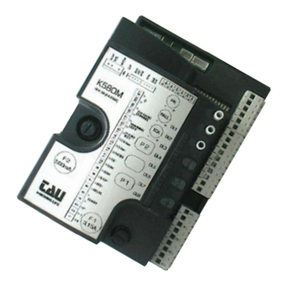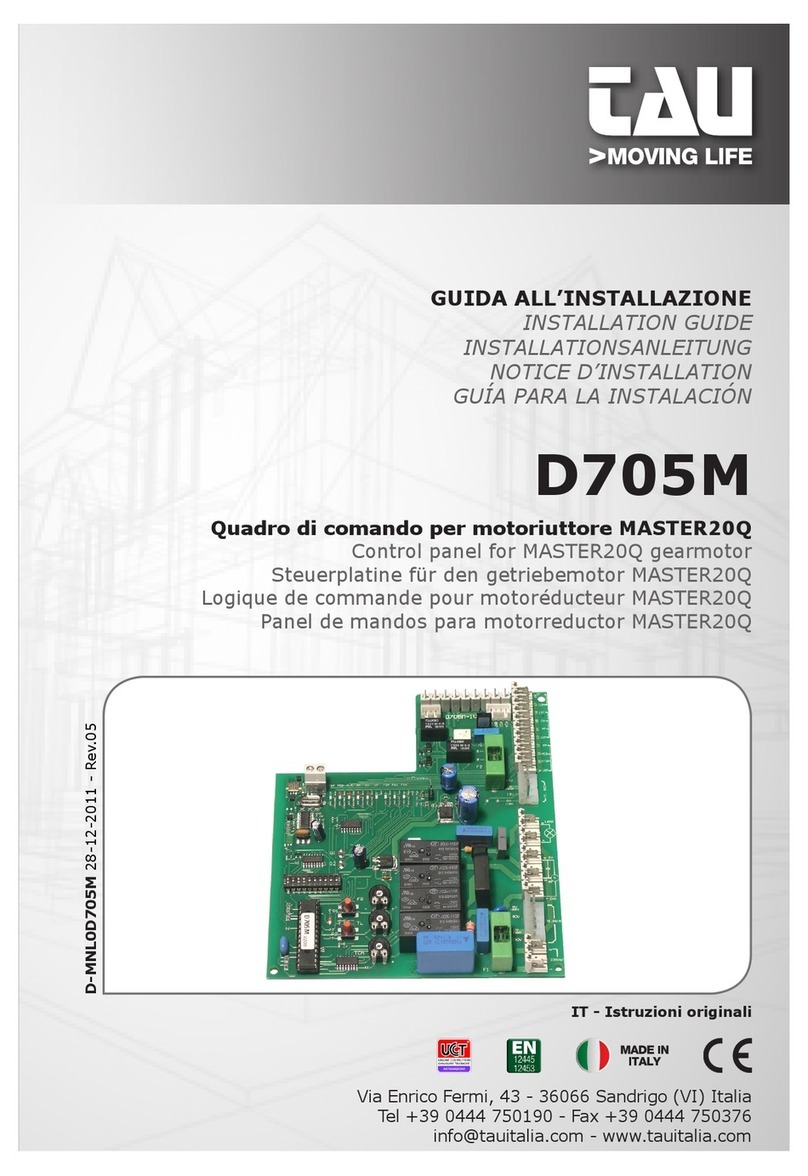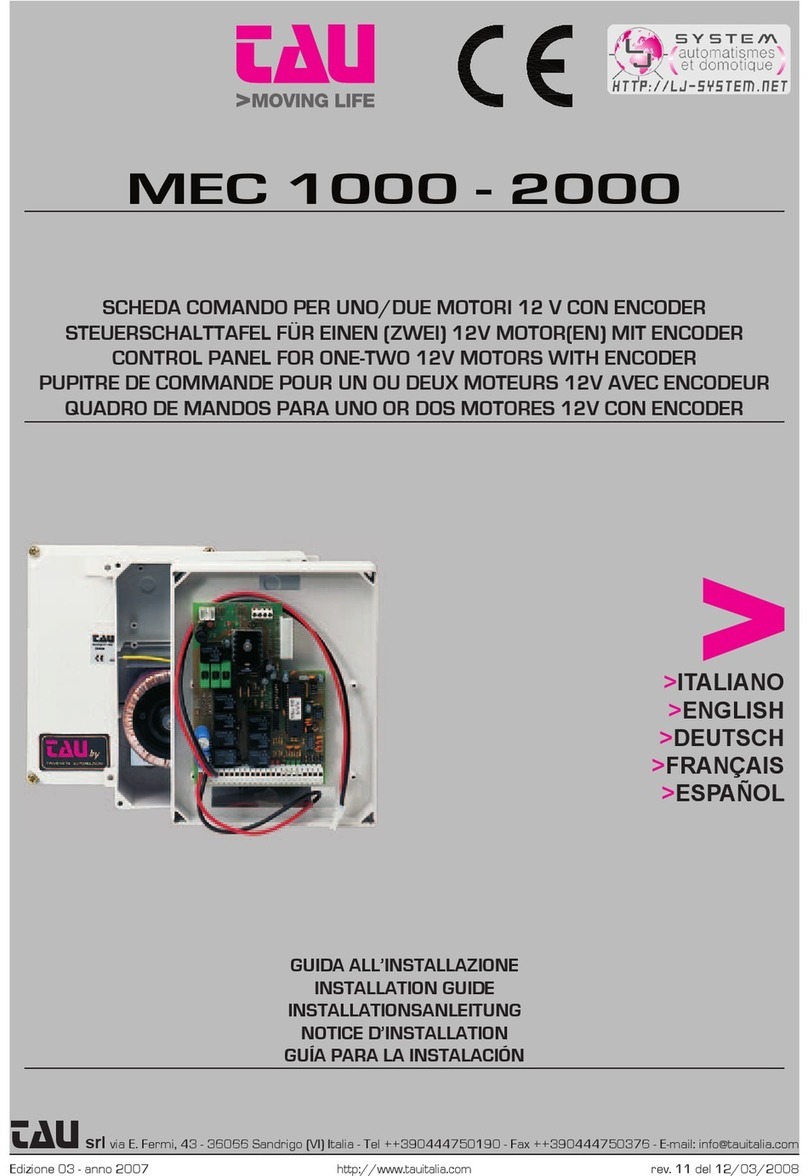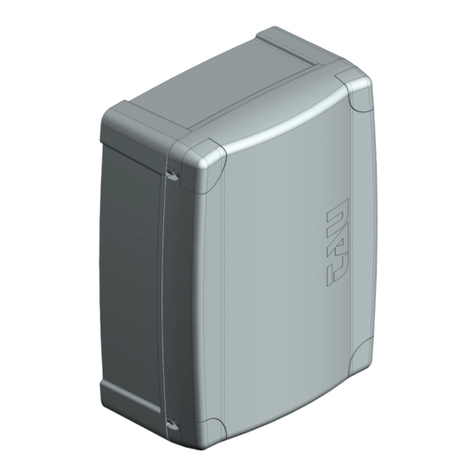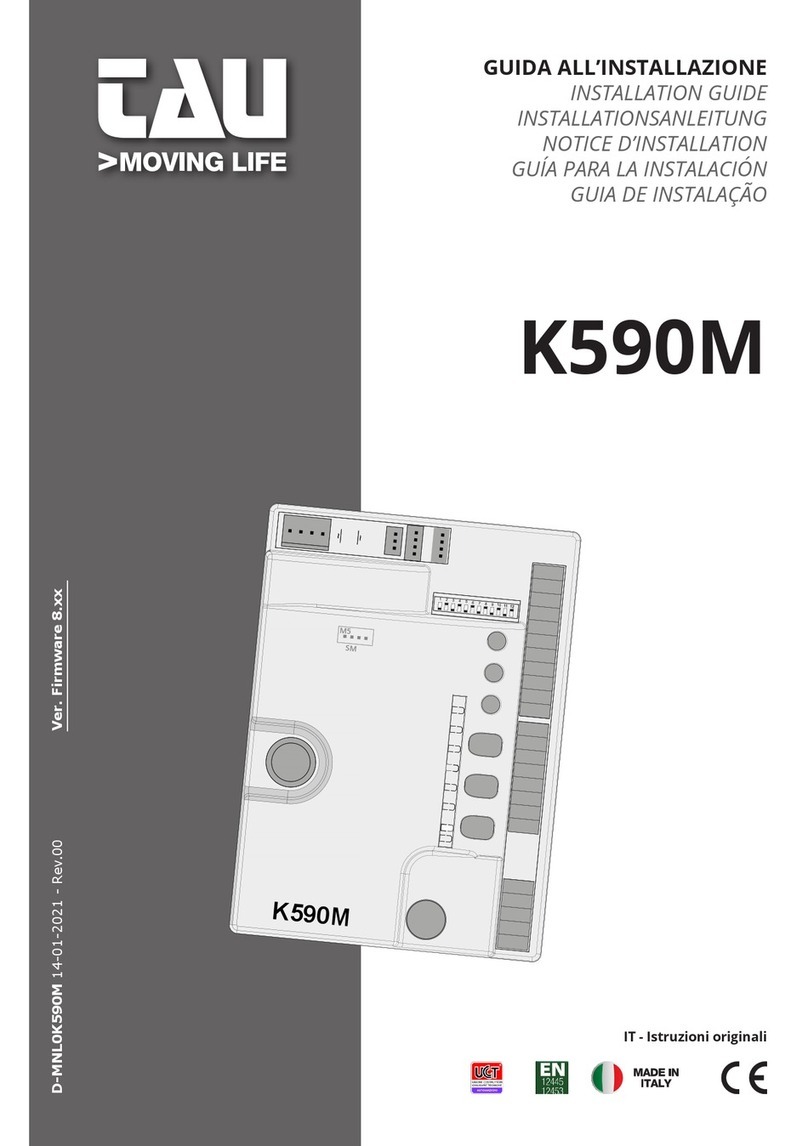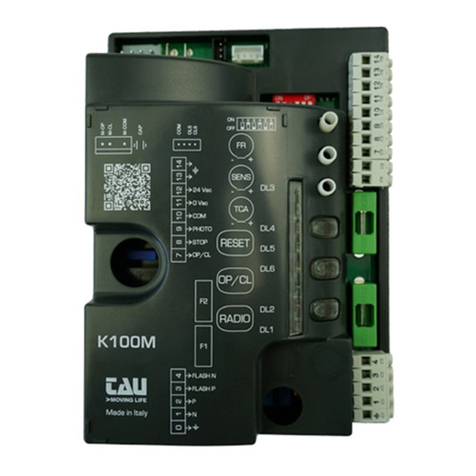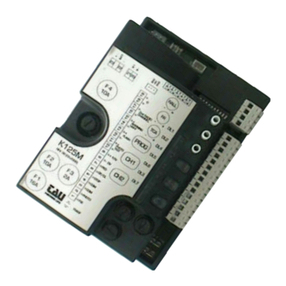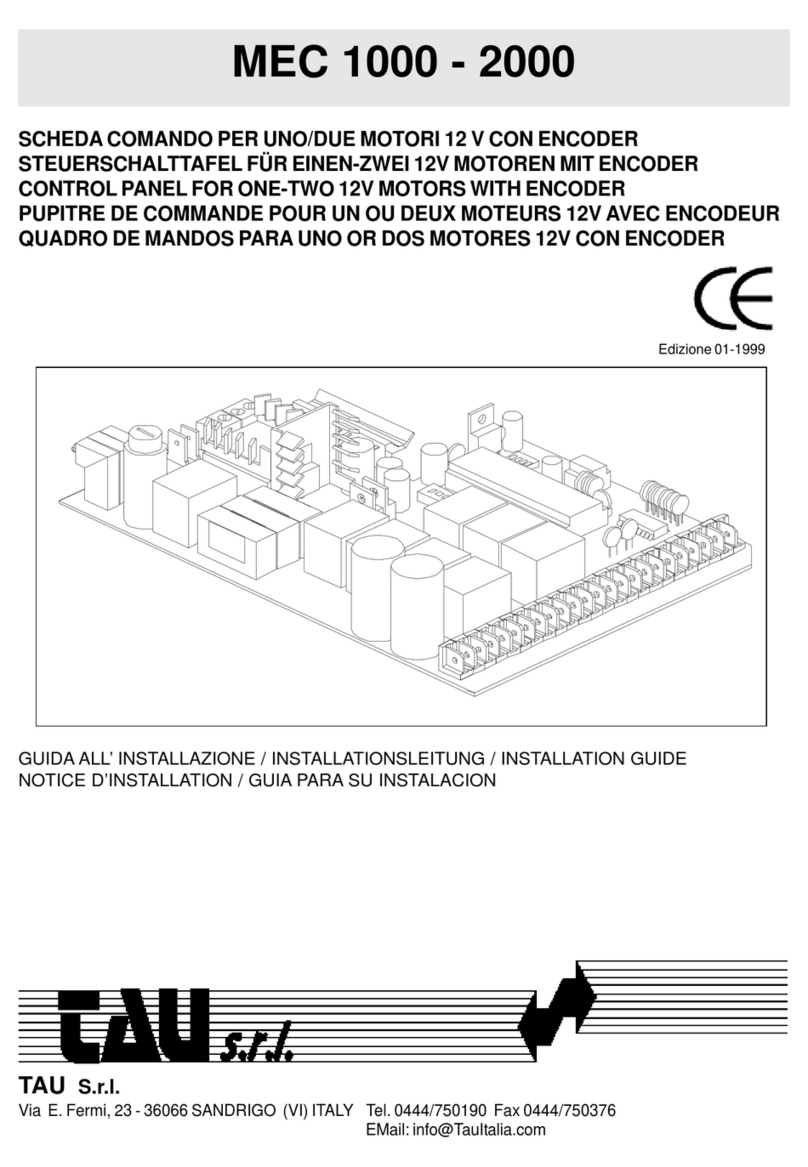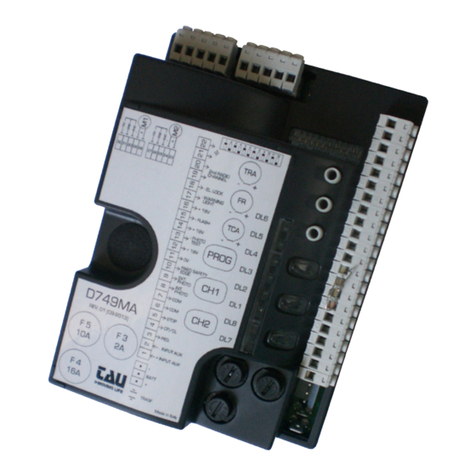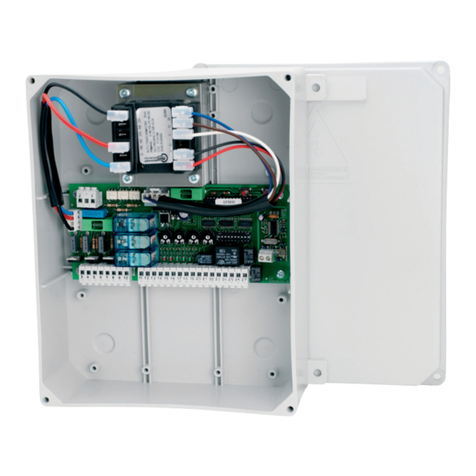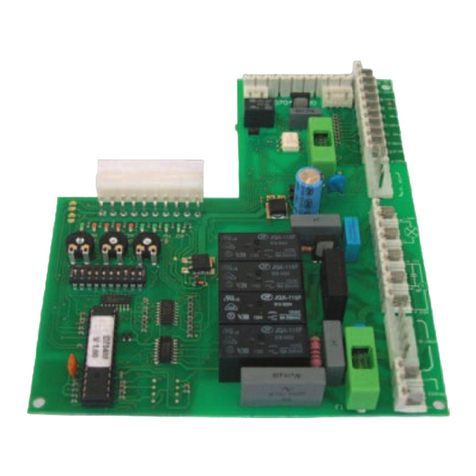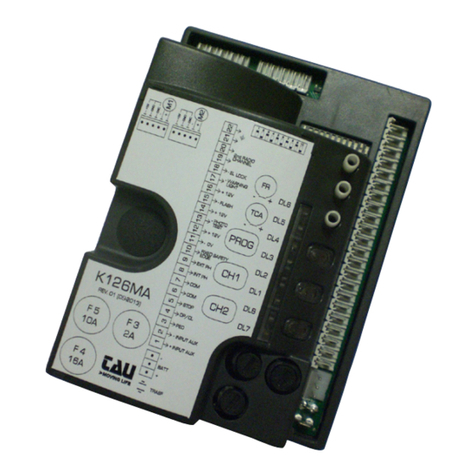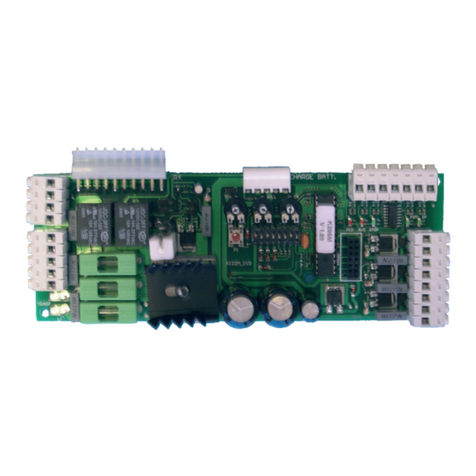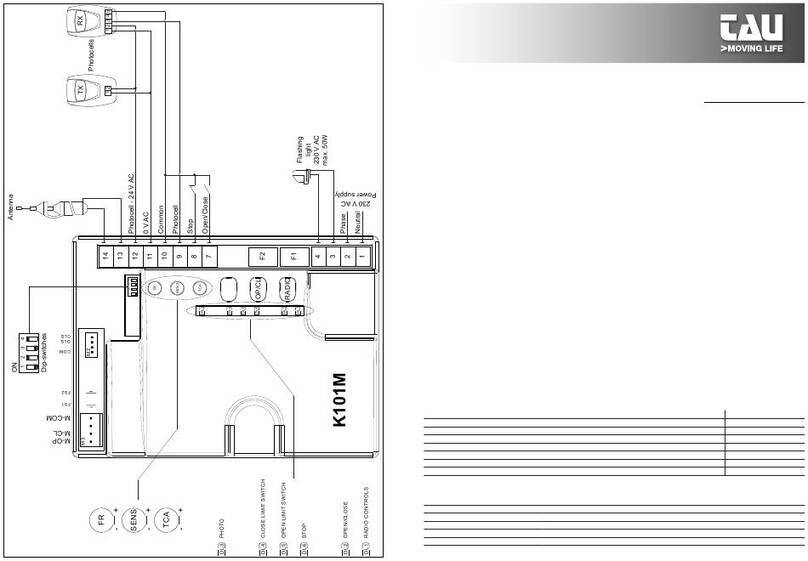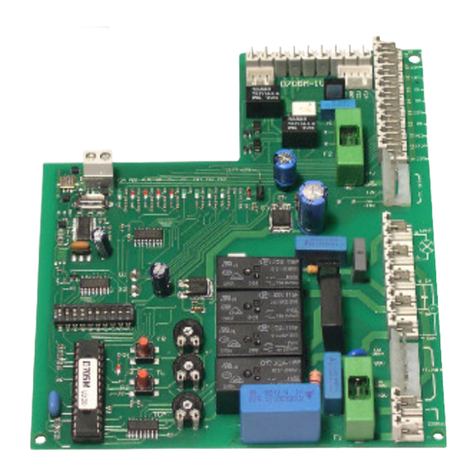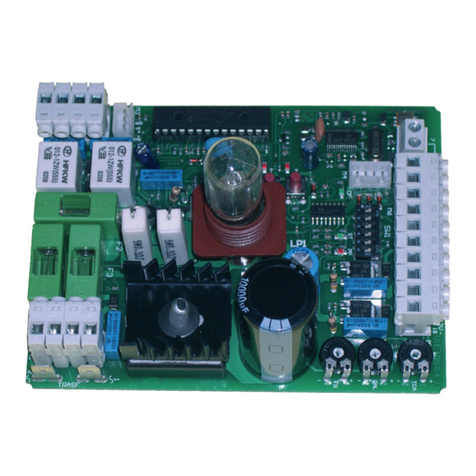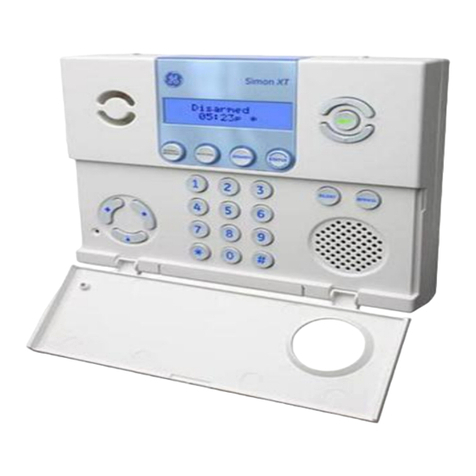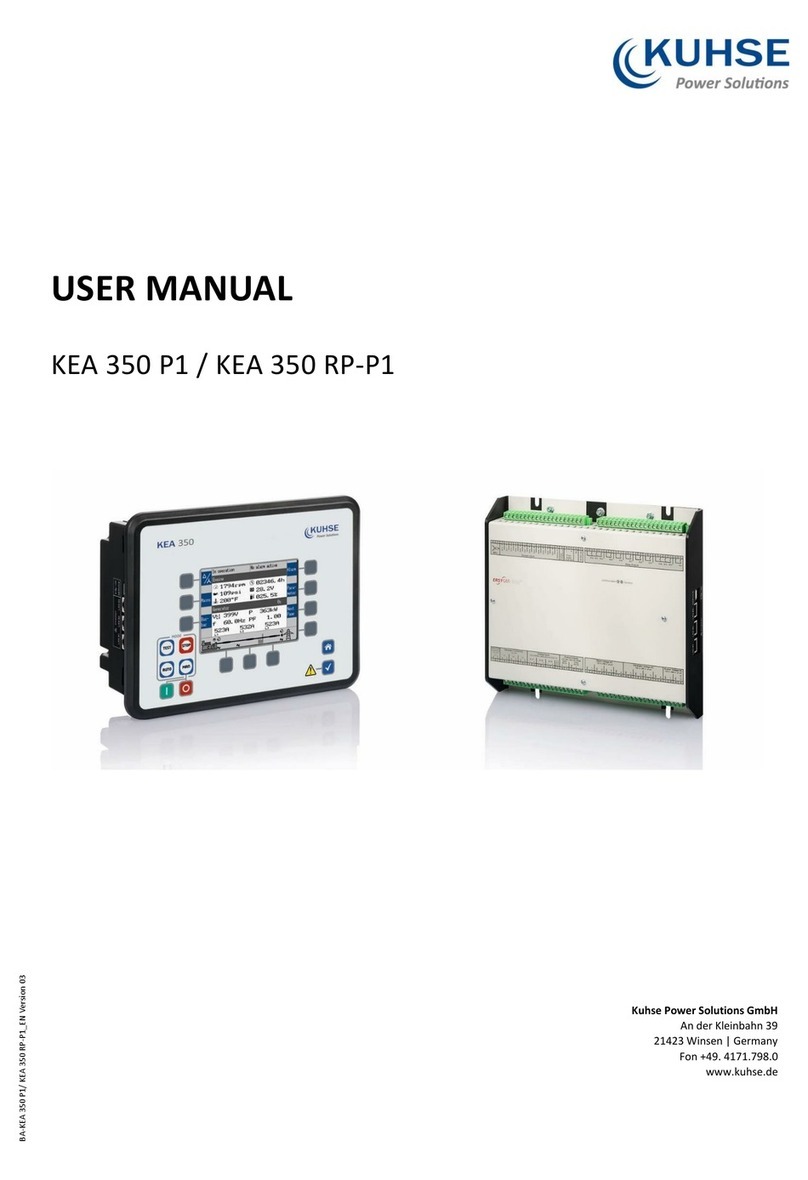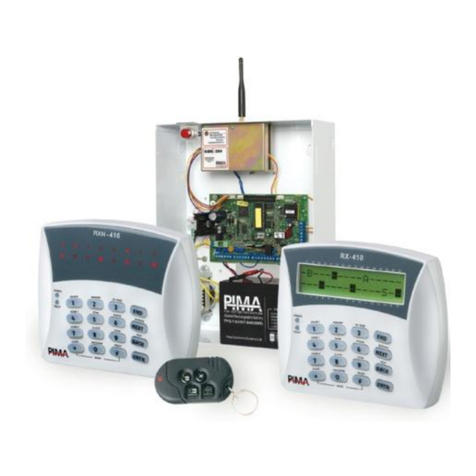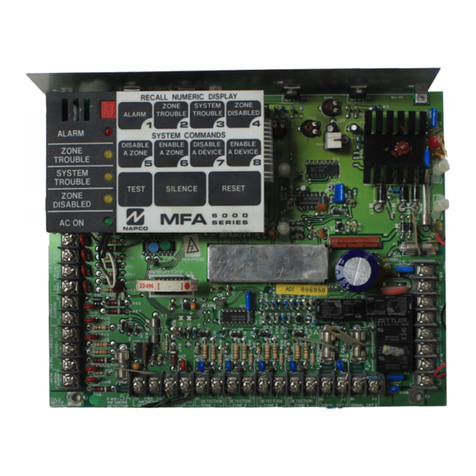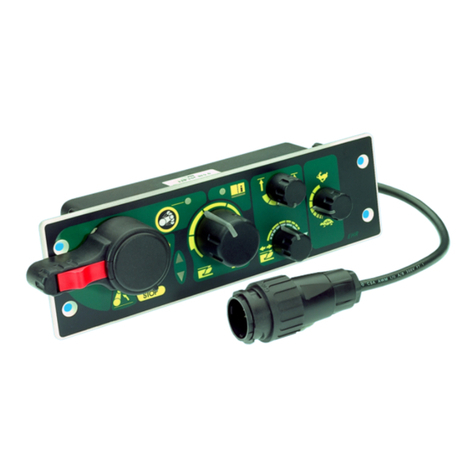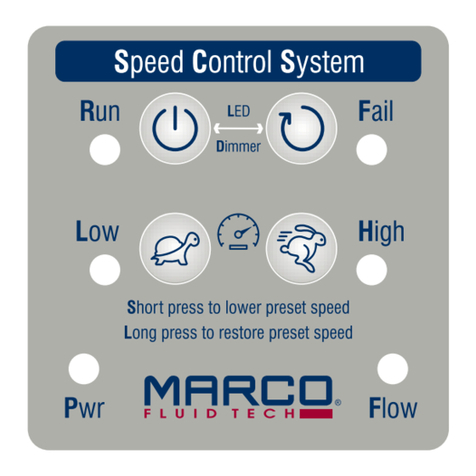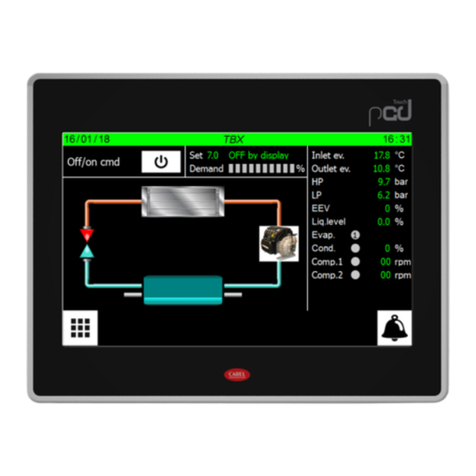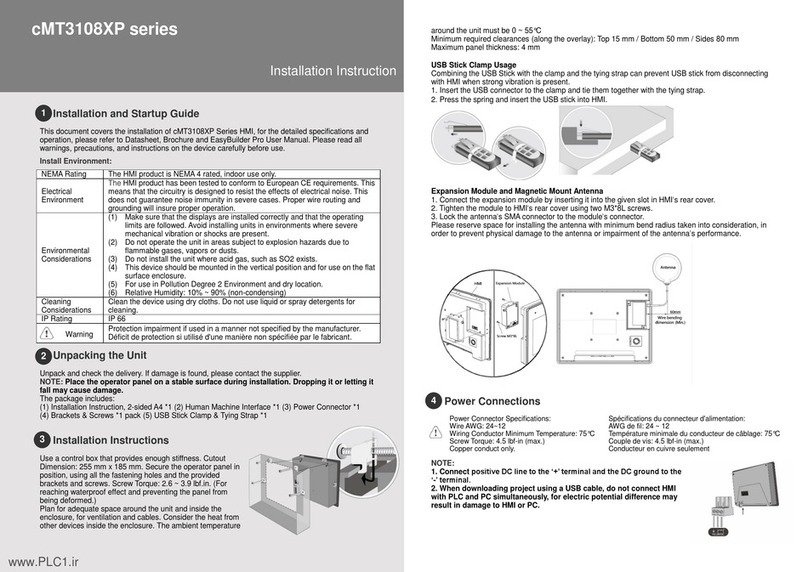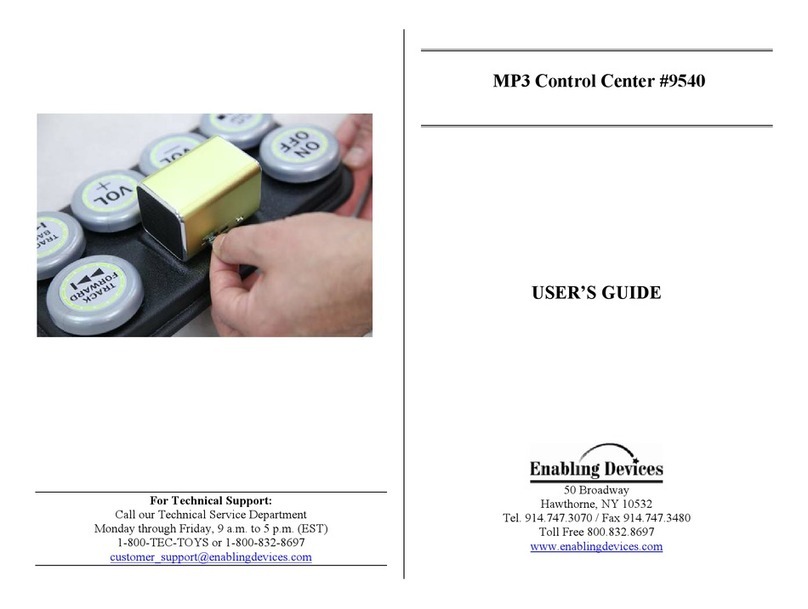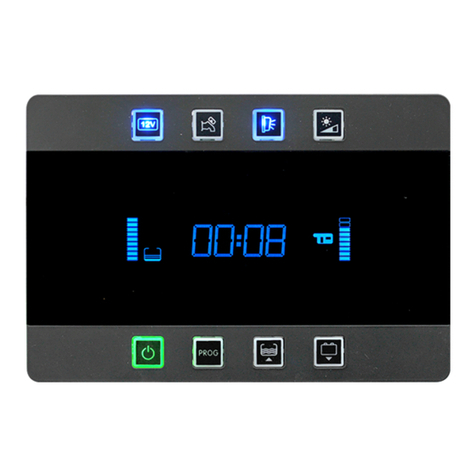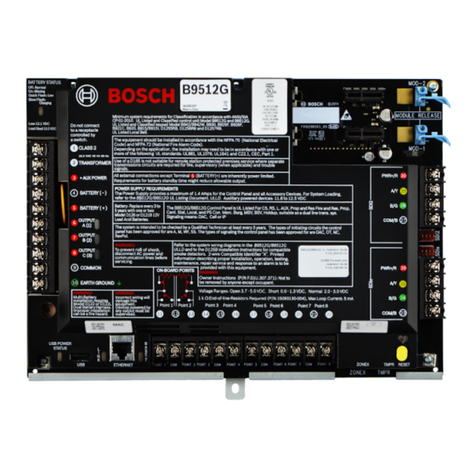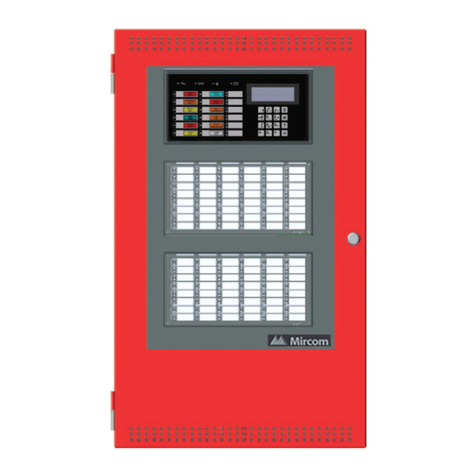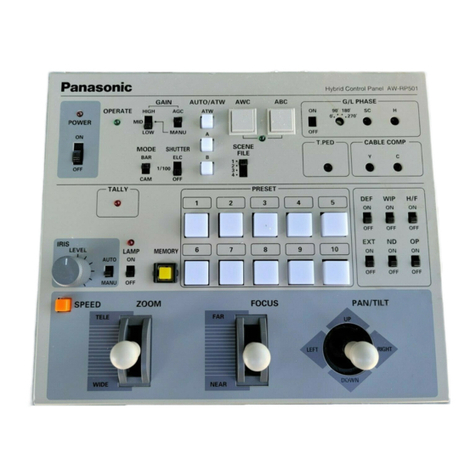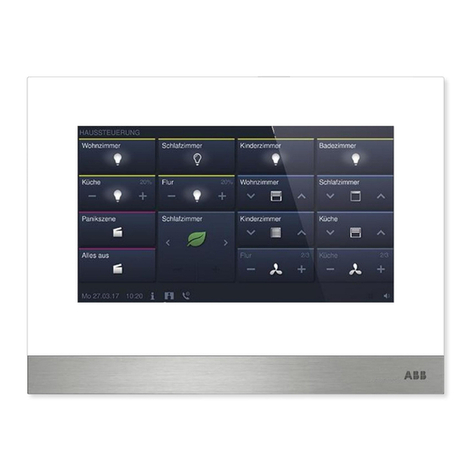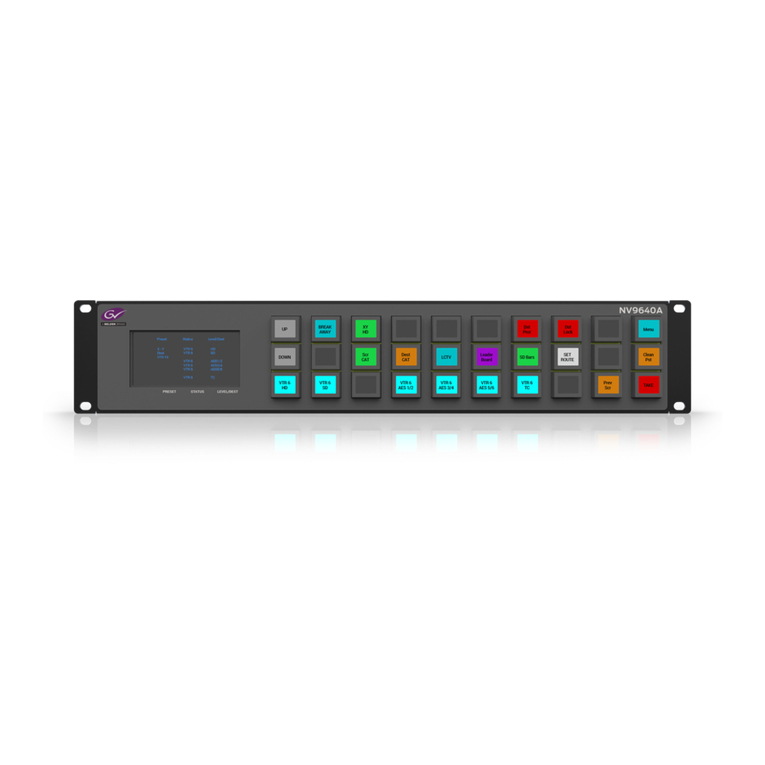tau D760M User manual

1
D760M
GUIDA ALL’INSTALLAZIONE
INSTALLATION GUIDE
INSTALLATIONSANLEITUNG
NOTICE D’INSTALLATION
GUÍA PARA LA INSTALACIÓN
GUIA DE INSTALAÇÃO
D760M
Quadro di comando per due motori monofase 230V AC
Control panel for two single-phase motors 230V AC
Steuerplatine für zwei einphasige 230V AC Motoren
Logique de commande pour
deux moteurs monophasés 230V AC
Panel de mandos para dos motores monofásicos 230V AC
Placa electrónica para dois motores monofásicos 230V AC
Via Enrico Fermi, 43 - 36066 Sandrigo (VI) Italia
Tel +39 0444 750190 - Fax +39 0444 750376
info@tauitalia.com - www.tauitalia.com
IT - Istruzioni originali
D-MNL0D760M 25-01-2016 - Rev.08
300
230
124

2
D760M
SCHEMA CABLAGGIO D760M / D760M WIRING DIAGRAM / SCHALTPLAN DER D760M
O/C =Open/Close
Ped = Pedestrian
Cap = Capacitor
TX = Transmitter
RX = Receiver
E.L. = Electric lock
M = Motor
I O
SPIA
AP2
230Vac
M3
12
12
345678910
3 4 5 6 7 8 9 10
CH1COM1 AP1CH2COM2 FOTI
11 12 13 14 15 16
COMAP/CH PED STOP CF COM
17 18
FOTE 24FOT
25
0VAC
26 2722 23 2419 20 21
11 12 13 14 15 16 17 18 25 26 2722 23 2419 20 21
24VAC
LAMP
F1
M2 M1
E.SERR 2 CH
P1 P2
J1
F2
28
28 29
29
R.ANTA FR. M1 CH.AUTO
FR. M2
230 Vac
Power supply
Flashing
light
230 Vac
max. 50W
Close
Common
Open
Close
Common
Open
Cap Cap
TX
1 2
RX
12345
Common
Sensitive edge
Internal photocell (N.C)
External photocell (N.C.)
Common
O/C
Ped
Stop
E.L.
12V 15W
2nd radio
channel
Gate open
warning light
max. 3W
Ext.
photoc.
Int.
photoc.
RX
12345
TX
1 2
Antenna
DL7
J1
DL7

3
D760M
SCHÉMA CÂBLAGE D760M / ESQUEMA DEL CABLEADO D760M / ESQUEMA ELÉCTRICO D760M
O/C =Open/Close
Ped = Pedestrian
Cap = Capacitor
TX = Transmitter
RX = Receiver
E.L. = Electric lock
M = Motor
I O
SPIA
AP2
230Vac
M3
1
2
12
345678910
3 4 5 6 7 8 9 10
CH1COM1 AP1CH2COM2 FOTI
11 12 13 14 15 16
COMAP/CH PED STOP CF COM
17 18
FOTE 24FOT
25
0VAC
26 2722 23 2419 20 21
11 12 13 14 15 16 17 18 25 26 2722 23 2419 20 21
24VAC
LAMP
F1
M2 M1
E.SERR 2 CH
P1 P2
J1
F2
28
28 29
29
R.ANTA FR. M1 CH.AUTO
FR. M2
230 Vac
Power supply
Flashing
light
230 Vac
max. 50W
Close
Common
Open
Close
Common
Open
Cap Cap
TX
1 2
RX
12345
Common
Sensitive edge
Internal photocell (N.C)
External photocell (N.C.)
Common
O/C
Ped
Stop
E.L.
12V 15W
2nd radio
channel
Gate open
warning light
max. 3W
Ext.
photoc.
Int.
photoc.
RX
12345
TX
1 2
Antenna
DL7
J1
DL7

4
D760M
DICHIARAZIONE DI INCORPORAZIONE DEL COSTRUTTORE
(ai sensi della Direttiva Europea 2006/42/CE AlI. II.B)
Fabbricante: TAU S.r.l.
Indirizzo: Via E. Fermi, 43
36066 Sandrigo (Vi)
ITALIA
Dichiara sotto la propria responsabilità che il prodotto: Centrale di comando
realizzato per il movimento automatico di: Cancelli a Battente
per uso in ambiente: Residenziale / Condominiale
completo di: Radioricevente
Modello: D760M
Tipo: D760M
Numero di serie: vedi etichetta argentata
Denominazione commerciale: Quadro di comando per due motori monofase
230V AC
È realizzato per essere incorporato su una chiusura (cancello a battente) o per essere assemblato con altri dispositivi
al ne di movimentare una tale chiusura per costituire una macchine ai sensi della Direttiva Macchine 2006/42/CE.
Dichiara inoltre che questo prodotto è conforme ai requisiti essenziali di sicurezza delle seguenti ulteriori direttive
CEE:
- 2006/95/CE Direttiva Bassa Tensione
- 2004/108/CE Direttiva Compatibilità Elettromagnetica
ed, ove richiesto, alla Direttiva:
- 1999/5/CE Apparecchiature Radio e apparecchiature terminali di telecomunicazione
Dichiara inoltre che non è consentito mettere in servizio il macchinario no a che la macchina in cui sarà
incorporato o di cui diverrà componente sia stata identicata e ne sia stata dichiarata la conformità alle condizioni
della Direttiva 2006/42/CE.
Si impegna a trasmettere, su richiesta adeguatamente motivata delle autorità nazionali, informazioni pertinenti sulle
quasi-macchine.
Sandrigo, 17/11/2014
Il Rappresentante Legale
_________________________________________
Loris Virgilio Danieli
Nome e indirizzo della persona autorizzata a costituire la documentazione tecnica pertinente:
Loris Virgilio Danieli - via E. Fermi, 43 - 36066 Sandrigo (Vi) Italia
ITALIANO

5
D760M
ITALIANO
AVVERTENZE
Il presente manuale è destinato solamente al personale tecnico quali cato per l’installazione.
Nessuna informazione contenuta nel presente fascicolo può essere considerata d’interesse per l’uti-
lizzatore nale. Questo manuale è allegato alla centralina D760M, non deve pertanto essere utilizzato
per prodotti diversi!
Avvertenze importanti:
Togliere l’alimentazione di rete alla scheda prima di accedervi.
La centralina D760M è destinata al comando di un motoriduttore elettromeccanico per l’automazione
di cancelli, porte e portoni.
Ogni altro uso è improprio e, quindi, vietato dalle normative vigenti.
È nostro dovere ricordare che l’automazione che state per eseguire, è classi cata come “costruzio-
ne di una macchina” e quindi ricade nel campo di applicazione della direttiva europea 2006/42/CE
(Direttiva Macchine).
Questa, nei punti essenziali, prevede che:
- l’installazione deve essere eseguita solo da personale qualicato ed esperto;
- chi esegue l’installazione dovrà preventivamente eseguire “l’analisi dei rischi” della macchina;
- l’installazione dovrà essere fatta a “regola d’arte”, applicando cioè le norme;
- inne dovrà essere rilasciata al proprietario della macchina la”dichiarazione di conformità”.
Risulta chiaro quindi che l’installazione ed eventuali interventi di manutenzione devono essere ef-
fettuati solo da personale professionalmente qualicato, in conformità a quanto previsto dalle leggi,
norme o direttive vigenti.
Nella progettazione delle proprie apparecchiture, TAU rispetta le normative applicabili al prodotto (ve-
dere la dichiarazione di conformità allegata); è fondamentale che anche l’installatore, nel realizzare
gli impianti, prosegua nel rispetto scrupoloso delle norme.
Personale non qualicato o non a conoscenza delle normative applicabili alla categoria dei “cancelli e
porte automatiche” deve assolutamente astenersi dall’eseguire installazioni ed impianti.
Chi non rispetta le normative è responsabile dei danni che l’impianto potrà causare!
Si consiglia di leggere attentamente tutte le istruzioni prima di procedere con l’installazione.
INSTALLAZIONE
Prima di procedere assicurarsi del buon funzionamento della parte meccanica. Vericare inol-
tre che il gruppo motoriduttore sia stato installato correttamente seguendo le relative istru-
zioni. Eseguiti questi controlli, assicurarsi che il motoriduttore non abbia un assorbimento
durante il movimento superiore a 3 A (per un corretto funzionamento del quadro di comando).
L’INSTALLAZIONE DELL’APPARECCHIATURA DEVE ESSERE EFFETTUATA “A REGOLA D’ARTE”
DA PERSONALE QUALIFICATO COME DISPOSTO DAL D.M. 37/08.
Nota: si ricorda l’obbligo di mettere a massa l’impianto nonché di rispettare le normative sulla
sicurezza in vigore in ciascun paese.
LA NON OSSERVANZA DELLE SOPRAELENCATE ISTRUZIONI PUÒ PREGIUDICARE IL BUON
FUNZIONAMENTO DELL’APPARECCHIATURA E CREARE PERICOLO PER LE PERSONE, PER-
TANTO LA “CASA COSTRUTTRICE” DECLINA OGNI RESPONSABILITÀ PER EVENTUALI MAL
FUNZIONAMENTI E DANNI DOVUTI ALLA LORO INOSSERVANZA.

6
D760M
SCHEDA DI COMANDO PER DUE MOTORI MONOFASE 230V AC
La scheda D760M è provvista di controllo elettronico delle sicurezze (fotocellule); tale verica viene
effettuata sulla fotocellula esterna solamente togliendo e ripristinando l’alimentazione, cosicchè il
microprocessore della centrale controlli che il relè abbia effettuato uno scambio senza problemi. Se
ciò non avviene, la centrale per sicurezza si blocca.
• LOGICA CON MICROPROCESSORE
• LEDS DI AUTODIAGNOSI
• PROTEZIONE INGRESSO LINEA CON FUSIBILE
• LIMITATORE DI COPPIA ELETTRONICO INCORPORATO
• VERIFICA ELETTRONICA DISPOSITIVI DI SICUREZZA
• FUNZIONE INGRESSO PEDONALE
• CIRCUITO LAMPEGGIO INCORPORATO
• RADIO RICEVITORE 433,92 MHz INTEGRATO A 2 CANALI (CH)
• FUNZIONE “RALLENTAMENTO” IN APERTURA E IN CHIUSURA
ATTENZIONE:
- non utilizzare cavi unilari (a conduttore unico), es. quelli citofonici, al ne di evitare
interruzioni sulla linea e falsi contatti;
- non riutilizzare vecchi cavi preesistenti.
COLLAUDO
A collegamento ultimato:
•I Leds verdi devono essere tutti accesi (corrispondono ciascuno ad un ingresso Normalmente
Chiuso).
•Si spengono solo quando sono interessate le sicurezze alle quali sono associati.
•I Leds rossi devono essere tutti spenti (corrispondono ciascuno ad un ingresso Normalmente
Aperto) si accendono solo quando sono attivi i comandi ai quali sono associati.
• Il Led rosso DL7 deve essere acceso sso (segnala lo stato logico della centrale, vedi sez. “Led
di diagnosi”).
CARATTERISTICHE TECNICHE
Alimentazione scheda 230V AC - 50Hz
Potenza nominale max. motori 600 W ca.
Fusibile rapido protezione linea (F1 - 5x20) F 3,15 A
Tensione circuiti alimentazione motore 230V AC
Tensione alimentazione circuiti dispositivi ausiliari 24V AC
Fusibile rapido protezione linea 24 V ac (F2 - 5x20) F 500 mA
Tensioni alimentazioni circuiti logici 5V DC
Temperatura di funzionamento -20°C ÷ + 55 °C
Grado di protezione del contenitore IP43
COLLEGAMENTI ALLA MORSETTIERA
Legenda:
N.C. = Normalmente Chiuso
N.A. = Normalmente Aperto
Morsetti Funzione Descrizione
1 - 2 ALIMENTAZIONE ingresso ALIMENTAZIONE 230 V ac 50 Hz monofase;
1= FASE, = TERRA, 2= NEUTRO.
3 - 4 LAMPEGGIANTE uscita LAMPEGGIANTE 230 V ac, 50 W max. Il segnale fornito è
già opportunamente modulato per l’uso diretto.
La frequenza di lampeggio è doppia in fase di chiusura;
5 - 6 - 7 MOTORE M1
uscita alimentazione MOTORE M1 (motore che apre l’anta del can-
cello con l’elettroserratura), 230 Vac, max 300 W;
5=CHIUDE, 6=COMUNE, 7=APRE.
Nota: collegare il condensatore fra i morsetti 5 e 7;
ITALIANO

7
D760M
8 - 9 - 10 MOTORE M2 uscita alimentazione MOTORE M2, 230 Vac, max 300 W; 8=CHIU-
DE, 9=COMUNE, 10=APRE.
Nota: collegare il condensatore fra i morsetti 8 e 10;
11 - 12 APRE/CHIUDE ingresso pulsante APRE/CHIUDE (contatto normalmente aperto);
per le modalità d’uso vedi le funzioni dei dip-switches nr 2 e 3.
(11=COMUNE);
11 - 13 PEDONALE ingresso contatto N.A. pulsante PEDONALE
Comanda l’apertura e la chiusura totale del motore 1 ed è regolato
nel funzionamento dai dip-switches 2 e 3 (11 = COMUNE);
11 - 14 STOP
ingresso pulsante STOP (contatto normalmente chiuso); il suo in-
tervento provoca l’arresto dell’automazione. Al successivo coman-
do l’automazione esegue una manovra opposta alla precedente
(11=COMUNE). Ponticellare i morsetti se non utilizzati;
15 - 18 BORDO
SENSIBILE
ingresso BORDO SENSIBILE (contatto pulito N.C., dip 10 OFF) o
BORDO SENSIBILE RESISTIVO 8,2 KΩ (dip 10 ON); Funziona solo
durante la fase di apertura e provoca la fermata temporanea dell’au-
tomazione e una parziale richiusura della stessa per circa 20 cm. libe-
rando così l’eventuale ostacolo (18=COMUNE). Ponticellare i morsetti
se non utilizzati;
16 - 18 FOTOCELLULE
INTERNE
Ingresso FOTOCELLULE O DISPOSITIVI DI SICUREZZA INTER-
NI all’automazione (contatto Normalmente chiuso);
18=COMUNE.
Il loro intervento, in fase di apertura, provoca l’arresto temporaneo
dell’automazione no a rimozione dell’ostacolo rilevato; in fase di
chiusura provoca l’arresto seguito dalla totale riapertura dell’auto-
mazione. Ponticellare i morsetti se non utilizzati;
17 - 18 FOTOCELLULE
ESTERNE
Ingresso FOTOCELLULE O DISPOSITIVI DI SICUREZZA ESTER-
NI all’automazione (contatto Normalmente chiuso);
18=COMUNE.
Il loro intervento, efcace solo in fase di chiusura, provoca l’arresto
seguito dalla totale riapertura dell’automazione.
Ponticellare i morsetti se non utilizzati;
Nota: Il trasmettittore della fotocellula deve sempre essere ali-
mentato dai mors. 25 - 27, in quanto su questi si effettua la ve-
rica del sistema di sicurezza (FOTOTEST), quindi senza que-
sto collegamento la centralina non accetterà nessun comando
di apertura. Per eliminare la verica del sistema di sicurezza
porre il dip-switch n°6 in posizione OFF.
19 - 20 ELETTRO
SERRATURA uscita alimentazione ELETTROSERRATURA
12 Vac max 15 W;
21 - 22 2° CH
RADIO
contatto 2° CANALE RADIO; modalità di funzionamento seleziona-
bile mediante i Dip 7 - 8;
Nota: per il collegamento di altri dispositivi al 2° canale radio,
quali accensione luci, comando pompe o carichi importanti,
utilizzare un relè ausiliario di potenza con portata adeguata ai
dispositivi da collegare, altrimenti si potrebbero avere malfun-
zionamenti dovuti a disturbi indotti.
23 - 24 SPIA
CANCELLO
APERTO
uscita SPIA CANCELLO APERTO; 24 V ac, max 3W; la spia si illu-
mina con la stessa frequenza del lampeggiante per tutta la corsa in
apertura e in chiusura per rimanere accesa se il cancello è aperto,
spenta a completamento della fase di chiusura;
25 - 27 TX
FOTOCELLULE
Uscita alimentazione 24 Vac fotocellula trasmittente esterna per
verica dispositivi di sicurezza. (collegare solo la fotocellula TX
esterna) max. nr. 2 trasmettitori fotocellule;
26 - 27 AUX Uscita 24Vac, 10W per l’alimentazione di fotocellule, ricevitori esterni, ecc.
28 - 29 ANTENNA ingresso ANTENNA (28=MASSA, 29=SEGNALE);
ITALIANO

8
D760M
REGOLAZIONI LOGICHE
TRIMMER
R. ANTA regolazione ritardo 2° motore: in chiusura da 0 a 30 sec. ca. (oltre al tempo che la scheda
calcola automaticamente durante la procedura di SETUP), in apertura da 0 a 6 sec. ca.
(oltre al tempo che la scheda calcola automaticamente durante la procedura di SETUP);
FR. M1
Regolazione coppia motore 1 (anta 1). Regolare il trimmer per una spinta del cancello
atta a garantire il funzionamento, facendo attenzione a non superare quella consentita
dalle norme in uso (EN 12453). Ruotando il trimmer in senso orario (+) si aumenta la
coppia motore, viceversa, ruotandolo in senso antiorario (-), diminuisce.
FR. M2
Regolazione coppia motore 2 (anta 2). Regolare il trimmer per una spinta del cancello
atta a garantire il funzionamento, facendo attenzione a non superare quella consentita
dalle norme in uso (EN 12453). Ruotando il trimmer in senso orario (+) si aumenta la
coppia motore, viceversa, ruotandolo in senso antiorario (-), diminuisce.
CH. AUTO regolazione tempo di richiusura automatica da 2 a 120 secondi.
NOTA: ruotando i TRIMMER in senso orario si aumentano le regolazioni, viceversa,
ruotandoli in senso antiorario, diminuiscono.
PROCEDURA DI IMPOSTAZIONE DELLA CORSA (SETUP)
Collegare, all’uscita AP/CH della centrale, un selettore a chiave oppure un pulsante con contatto N.A.
quindi, per regolare la corsa delle ante, eseguire la seguente procedura:
- Se è già stata eseguita la procedura di memorizzazione del radiocomando, lo si può usare per
comandare la procedura;
CANCELLO 2 ANTE - DIP 4 ON (rallentamento inserito):
1 premere e mantenere premuto per almeno 5 secondi i pulsanti P1 e P2 per attivare la procedura;
2 il led DL7 comincia a lampeggiare velocemente, a segnalazione che la procedura è attiva;
3 premere AP/CH (o il radiocomando), le 2 ante si aprono;
4 ad apertura completata, premere AP/CH (o il radiocomando), le 2 ante si arrestano;
5 premere AP/CH (o il radiocomando), l’anta 2 si aziona in “corsa veloce” di chiusura;
6 premere AP/CH nel punto desiderato per iniziare il rallentamento;
7 ad anta completamente chiusa premere AP/CH (acquisizione corsa anta 2 completata);
8 premere AP/CH, l’anta 1 si aziona in “corsa veloce” di chiusura;
9 premere AP/CH nel punto desiderato per iniziare il rallentamento;
10 ad anta completamente chiusa premere AP/CH (acquisizione corsa anta 1 completata);
11 il led DL7 smette di lampeggiare ad intermittenza per accendersi sso subito dopo (dati acquisiti
e memorizzati correttamente);
CANCELLO 1 ANTA - DIP 4 ON (rallentamento inserito):
1 premere e mantenere premuto per almeno 5 secondi i pulsanti P1 e P2 per attivare la procedura;
2 il led DL7 comincia a lampeggiare velocemente, a segnalazione che la procedura è attiva;
3 premere AP/CH (o il radiocomando), l’anta si apre;
4 ad apertura completata, premere AP/CH (o il radiocomando), l’anta si arresta;
5 premere 4 volte AP/CH, l’anta si aziona in “corsa veloce” di chiusura;
6 premere AP/CH nel punto desiderato per iniziare il rallentamento;
7 ad anta completamente chiusa premere AP/CH (acquisizione corsa anta completata);
8 il led DL7 smette di lampeggiare ad intermittenza per accendersi sso subito dopo (dati acquisiti
e memorizzati correttamente);
CANCELLO 2 ANTE - DIP 4 OFF (rallentamento disabilitato):
1 premere e mantenere premuto per almeno 5 secondi i pulsanti P1 e P2 per attivare la procedura;
2 il led DL7 comincia a lampeggiare velocemente, a segnalazione che la procedura è attiva;
3 premere AP/CH (o il radiocomando), le 2 ante si aprono;
4 ad apertura completata, premere AP/CH (o il radiocomando), le 2 ante si arrestano;
5 premere AP/CH (o il radiocomando), l’anta 2 si aziona in “corsa veloce” di chiusura;
6 ad anta completamente chiusa premere AP/CH (acquisizione corsa anta 2 completata);
7 premere AP/CH, l’anta 1 si aziona in “corsa veloce” di chiusura;
8 ad anta completamente chiusa premere AP/CH (acquisizione corsa anta 1 completata);
9 il led DL7 smette di lampeggiare ad intermittenza per accendersi sso subito dopo (dati acquisiti
e memorizzati correttamente).
ITALIANO

9
D760M
CANCELLO 1 ANTA - DIP 4 OFF (rallentamento disabilitato):
1 premere e mantenere premuto per almeno 5 secondi i pulsanti P1 e P2 per attivare la procedura;
2 il led DL7 comincia a lampeggiare velocemente, a segnalazione che la procedura è attiva;
3 premere AP/CH (o il radiocomando), l’ante si apre;
4 ad apertura completata, premere AP/CH (o il radiocomando), l’anta si arresta;
5 premere 3 volte AP/CH, l’anta si aziona in “corsa veloce” di chiusura;
6 ad anta completamente chiusa premere AP/CH (acquisizione corsa anta completata);
7 il led DL7 smette di lampeggiare ad intermittenza per accendersi sso subito dopo (dati acquisiti
e memorizzati correttamente).
Note:
- durante la procedura di SETUP i dispositivi di sicurezza sono disattivati.
- in qualsiasi momento tramite l’ingresso STOP si può arrestare l’acquisizione della corsa.
La procedura rimane attiva ed è possibile riprendere dal punto1;
- con il led DL7 lampeggiante, premendo P1 e P2 contemporaneamente per oltre 5 secondi
si annulla la procedura.
- Si consiglia di di impostare un tempo di qualche secondo superiore al necessario per
garantire la completa apertura/chiusura delle ante.
DIP-SWITCHES
1CHIUSURA
AUTOMATICA
On ad apertura completata, la chiusura del cancello è automatica
trascorso un tempo impostato sul trimmer T.C.A.;
Off la chiusura necessita di un comando manuale;
22 / 4 TEMPI
On ad automazione funzionante, una sequenza di comandi di apertura/
chiusura induce il cancello ad una APERTURA-CHIUSURA-
APERTURA-CHIUSURA, etc. (vedi anche dip switch 3);
Off nelle stesse condizioni, la stessa sequenza di comandi di apertura/
chiusura induce il cancello ad una APERTURA-STOP-CHIUSURA-
STOP-APERTURA-STOP, etc. (funzione passo-passo);
3NO REVERSE On il cancello in fase di apertura ignora i comandi di chiusura (NO
REVERSE);
Off il cancello si comporta secondo la regolazione del dip-switch 2;
4RALLENTAMENTO On la funzione rallentamento è inserita (vedi “PROCEDURA DI IMPO-
STAZIONE DELLA CORSA”);
Off la funzione rallentamento è esclusa;
5PRE-LAMPEGGIO On la funzione prelampeggio è abilitata;
Off la funzione prelampeggio è disabilitata;
6FOTOTEST
On la funzione “verica delle fotocellule” è inserita;
Off la funzione “verica delle fotocellule” è disinserita. N.B.: da utilizzare
quando non si usano le fotocellule;
7 - 8 funzionamento 2° CANALE RADIO (morsetti nr 21 - 22);
Dip 7 Dip 8 Funzione
OFF OFF Contatto cancello aperto: il contatto si attiva all’apertura del cancello, rimane
attivo durante il tempo di apertura, durante il TCA e durante la richiusura. Si
disattiva una volta che il cancello ha completato la chiusura.
OFF ON Funzione bistabile attiva: all’ impulso del radiocomado il contatto si attiva e
rimane tale no al successivo impulso.
ON OFF Funzione monostabile attiva 2 sec.: all’ impulso del radiocomado il contatto si
attiva e rimane tale per 2 sec.
ON ON Funzione monostabile attiva 180 sec.: all’ impulso del radiocomado il contatto
si attiva e rimane tale per 180 sec.
9COLPO D’ARIETE On la funzione “colpo d’ariete” è inserita. Permette lo sgancio dell’e-
lettroserratura (da utilizzarsi solo se è presente l’elettroserratura);
Off la funzione “colpo d’ariete” è disinserita;
ITALIANO

10
D760M
10 SELEZIONE
BORDO SENSIBILE
On BORDO SENSIBILE RESISTIVO (morsetto nr 15);
Off BORDO SENSIBILE contatto pulito N.C. (morsetto nr 15).
Nota: lasciare in OFF se non utilizzato;
PONTICELLO J1
Ponticellato= in seguito all’intervento del contatto fotocellula esterna (ingresso 17 - 18), l’au-
tomazione si chiude automaticamente dopo 5 secondi.
Non ponticellato= funzione disinserita.
ATTENZIONE:
Per ogni coppia di morsetti facenti capo ad un contatto N.C. non utilizzato, bisogna effettuare un
cortocircuito per poter garantire il normale funzionamento della scheda.
L’impianto di massa a terra del portone deve essere conforme alle norme vigenti. La Casa Costruttrice
declina ogni responsabilità per i danni derivanti da eventuali inosservanze in materia.
RADIO RICEVITORE 433,92 MHz INTEGRATO
Il radio ricevitore può apprendere no ad un max di 30 codici rolling code (BUG2R, BUG4R, K-SLIM-
RP, T-4RP) da impostare liberamente su due canali.
Il primo canale comanda direttamente la scheda di comando per l’apertura dell’automazione; il secondo
canale comanda un relè per un contatto pulito N.A. in uscita (morsetti nr 21 e 22, max 24 Vac, 1 A).
APPRENDIMENTO RADIOCOMANDI
P1 = APRE/CHIUDE
P2 = 2° canale
1_ premere brevemente il tasto P1 se si desidera associare un radiocomando alla funzione APRE/
CHIUDE;
2_ il led DL7 si spegne per indicare la modalità di apprendimento dei codici (se non viene immesso
nessun codice entro 10 secondi, la scheda esce dalla modalità di programmazione);
3_ premere il tasto del radiocomando che si desidera utilizzare;
4_ il led DL7 si riaccende per segnalare l’avvenuta memorizzazione (se ciò non accade, attendere 10
secondi e riprendere dal punto 1);
5_ se si desidera memorizzare altri radiocomandi, ripetere la procedura dal punto 1 no ad un massimo
di 30 trasmettitori;
6_ se si desidera effettuare la memorizzazione sul 2° canale, ripetere la procedura dal punto 1
utilizzando il tasto P2 anzichè il tasto P1;
7_ se si desidera uscire dalla modalità di apprendimento senza memorizzare un codice, premere
brevemente il tasto P1 o il tasto P2.
Nota: nel caso di superamento del nr massimo di radiocomandi (nr 30), il led DL7 inizierà a
lampeggiare velocemente per circa 3 secondi senza però eseguire la memorizzazione.
PROGRAMMAZIONE REMOTA TRAMITE T-4RP e K-SLIM-RP (V 4.X)
Con la versione di software V 4.X è possibile eseguire l’apprendimento remoto con i radiocomandi T-
4RP e K-SLIM-RP (V 4.X), ossia senza agire direttamente sui tasti di programmazione della ricevente.
Sarà sufciente disporre di un radiocomando già programmato nella ricevente per poter aprire la
procedura di programmazione remota dei nuovi radiocomandi. Seguire la procedura riportata sulle
istruzioni del radiocomando T-4RP e K-SLIM-RP (V 4.X).
CANCELLAZIONE RADIOCOMANDI
1_ tenere premuto per 3 secondi ca. il tasto P1 al ne di cancellare tutti i radiocomandi ad esso
associati;
2_ il led DL7 inizia a lampeggiare lentamente per indicare che la modalità di cancellazione è attivata;
3_ tenere pemuto nuovamente il tasto P1 per 3 secondi;
4_ il led DL7 si spegne per 3 secondi ca. per poi riaccendersi sso ad indicare l’avvenuta cancellazione;
5_ riprendere la procedura dal punto 1 utilizzando il tasto P2 per cancellare tutti i radiocomandi ad
esso associati;
6_ se si desidera uscire dalla modalità di cancellazione senza memorizzare un codice, premere
brevemente il tasto P1 o il tasto P2.
ITALIANO

11
D760M
LED DI DIAGNOSI
DL1 - Rosso led di segnalazione pulsante APRE/CHIUDE
DL2 - Rosso led di segnalazione pulsante PEDONALE
DL3 - Verde led di segnalazione pulsante STOP
DL4 - Verde led di segnalazione BORDO SENSIBILE
DL5 - Verde led di segnalazione FOTOCELLULE INTERNE
DL6 - Verde led di segnalazione FOTOCELLULE ESTERNE
DL7 - Rosso led di segnalazione programmazione RADIOCOMANDI ed ERRORI
led di segnalazione dello stato della centrale di comando
SEGNALAZIONE LED DL7
Acceso sso = funzionamento regolare
2 lampeggi = errore test fotocellula
7 lampeggi = errore corsa non impostata
Lampeggi veloci = procedura acquisizione corsa attiva
MALFUNZIONAMENTI: POSSIBILI CAUSE E RIMEDI
L’automazione non parte
a- Vericare con lo strumento (Multimetro) la presenza dell’alimentazione 230Vac;
b- Vericare che i contatti N.C. della scheda siano effettivamente normalmente chiusi (4 led verdi
accesi);
c- Impostare il dip 6 (fototest) su OFF;
d- Controllare con lo strumento (Multimetro) che i fusibili siano integri.
Il radiocomando ha poca portata
a- Controllare che il collegamento della massa e del segnale dell’antenna non sia invertito;
b- Non eseguire giunzioni per allungare il cavo dell’antenna;
c- Non installare l’antenna in posizioni basse o in posizioni nascoste dalla muratura o dal pila-
stro;
d- Controllare lo stato delle pile del radiocomando.
Il cancello si apre al contrario
Invertire tra loro i collegamenti dei motori sulla morsettiera (morsetti 5 e 7 per il motore 1; morsetti
8 e 10 per il motore 2);
GARANZIA: CONDIZIONI GENERALI
La garanzia della TAU ha durata di 24 mesi dalla data di acquisto dei prodotti (fa fede il documento
scale di vendita, scontrino o fattura).
La garanzia comprende la riparazione con sostituzione gratuita (franco sede TAU: spese di imballo e
di trasporto sono a carico del cliente) delle parti che presentano difetti di lavorazione o vizi di materiale
riconosciuti dalla TAU.
In caso di intervento a domicilio, anche nel periodo coperto da garanzia, l’utente è tenuto a corrispon-
dere il “Diritto sso di chiamata” per spese di trasferimento a domicilio, più manodopera.
La garanzia decade nei seguenti casi:
• Qualora il guasto sia determinato da un impianto non eseguito secondo le istruzioni fornite
dall’azienda all’interno di ogni confezione.
• Qualora non siano stati impiegati tutti componenti originali TAU per l’installazione dell’automa-
tismo.
• Qualora i danni siano causati da calamità naturali, manomissioni, sovraccarico di tensione,
alimentazione non corretta, riparazioni improprie, errata installazione, o altre cause non impu-
tabili alla TAU.
• Qualora non siano state effettuate le manutenzioni periodiche da parte di un tecnico specia-
lizzato secondo le istruzioni fornite dall’azienda all’interno di ogni confezione.
• Usura dei componenti.
La riparazione o la sostituzione dei pezzi durante il periodo di garanzia non comporta un prolunga-
mento del termine di scadenza della garanzia stessa.
In caso di utilizzo industriale o professionale oppure in caso di impiego simile, tale garanzia ha validità
12 mesi.
ITALIANO

12
D760M
MANUFACTURER’S DECLARATION OF INCORPORATION
(in accordance with European Directive 2006/42/EC App. II.B)
Manufacturer: TAU S.r.l.
Address: Via E. Fermi, 43
36066 Sandrigo (Vi)
ITALY
Declares under its sole responsibility, that the product: Electronic control unit
designed for automatic movement of: Swing Gates
for use in a: Residential / Communities
complete with: Radioreceiver
Model: D760M
Type: D760M
Serial number: see silver label
Commercial name: Control panel for two single-phase motors
230V AC
Has been produced for incorporation on an access point (swing gate) of for assembly with other devices used to
move such an access point, to constitute a machine in accordance with the Machinery Directive 2006/42/EC.
Also declares that this product complies with the essential safety requirements of the following EEC directives:
- 2006/95/EC Low Voltage Directive
- 2004/108/EC Electromagnetic Compatibility Directive
and, where required, with the Directive:
- 1999/5/CE Radio equipment and telecommunications terminal equipment
Also declares that it is not permitted to start up the machine until the machine in which it is incorporated or of
which it will be a component has been identied with the relative declaration of conformity with the provisions of
Directive 2006/42/EC.
The manufacturer undertakes to provide, on sufciently motivated request by national authorities, all information
pertinent to the quasi-machinery.
Sandrigo, 17/11/2014
Legal Representative
_________________________________________
Loris Virgilio Danieli
Name and address of person authorised to draw up all pertinent technical documentation:
Loris Virgilio Danieli - via E. Fermi, 43 - 36066 Sandrigo (Vi) Italy
ENGLISH

13
D760M
ENGLISH
WARNINGS
This manual has been especially written for use by quali ed tters. No information given in this
manual can be considered as being of interest to end users. This manual is enclosed with control unit
D760M and may therefore not be used for different products!
Important information:
Disconnect the panel from the power supply before opening it.
The D760M control unit has been designed to control an electromechanical gear motor for automating
gates and doors of all kinds.
Any other use is considered improper and is consequently forbidden by current laws.
Please note that the automation system you are going to install is classi ed as “machine construction”
and therefore is included in the application of European directive 2006/42/EC (Machinery Directive).
This directive includes the following prescriptions:
- Only trained and qualied personnel should install the equipment;
- the installer must rst make a “risk analysis” of the machine;
- the equipment must be installed in a correct and workmanlike manner in compliance with all the
standards concerned;
- after installation, the machine owner must be given the “declaration of conformity”.
This product may only be installed and serviced by qualied personnel in compliance with current,
laws, regulations and directives.
When designing its products, TAU observes all applicable standards (please see the attached decla-
ration of conformity) but it is of paramount importance that installers strictly observe the same stand-
ards when installing the system.
Unqualied personnel or those who are unaware of the standards applicable to the “automatic gates
and doors” category may not install systems under any circumstances.
Whoever ignores such standards shall be held responsible for any damage caused by the
system!
Do not install the unit before you have read all the instructions.
INSTALLATION
Before proceeding, make sure the mechanical components work correctly. Also check that the
gear motor assembly has been installed according to the instructions. Then make sure that
the power consumption of the gear motor is not greater than 3A (otherwise the control panel
may not work properly).
THE EQUIPMENT MUST BE INSTALLED “EXPERTLY” BY QUALIFIED PERSONNEL AS RE-
QUIRED BY LAW.
Note: it is compulsory to earth the system and to observe the safety regulations that are in
force in each country.
IF THESE ABOVE INSTRUCTIONS ARE NOT FOLLOWED IT COULD PREJUDICE THE PROPER
WORKING ORDER OF THE EQUIPMENT AND CREATE HAZARDOUS SITUATIONS FOR PEO-
PLE. FOR THIS REASON THE “MANUFACTURER” DECLINES ALL RESPONSIBILITY FOR ANY
MALFUNCTIONING AND DAMAGES THUS RESULTING.

14
D760M
CONTROL CARD FOR TWO SINGLE-PHASE MOTORS 230V AC
The D760M panel features an electronic photocell control system which switches the external photo-
cell transmitter on and off thereby causing the control unit microprocessor to check whether the relay
switches correctly. If this does not happen, the control unit is automatically blocked.
• MICROPROCESSOR-CONTROLLED LOGIC
• SELF-DIAGNOSIS LED’s
• LINE INPUT FUSE
• BUILT-IN TORQUE LIMITING DEVICE
• ELECTRONIC CONTROL OF SAFETY DEVICES
• PEDESTRIAN ENTRY FUNCTION
• BUILT-IN FLASHING LIGHT CIRCUIT
•433.92 MHz 2 CHANNEL BUILT-IN RADIO RECEIVER (CH)
• “SLOW-DOWN” FUNCTION IN OPENING AND IN CLOSING PHASE
ATTENTION:
- do not use single cables (with one single wire), ex. telephone cables, in order to avoid
breakdowns of the line and false contacts;
- do not re-use old pre-existing cables.
TESTING
When all connections have been made:
• All the green LED’s must be on (each corresponds to a Normally Closed input).
• They only turn off when the safeties they are associated with are active.
• All the red LED’s must be off (each corresponds to a Normally Open input) they only turn on when
the commands they are associated with are active.
•The red Led DL7 must be always on (indicates the logic state of the control unit, see sect. “Diag-
nostics Led”)
TECHNICAL CHARACTERISTICS
Power input to board 230V AC - 50Hz
Max motors nominal power 600 W ca.
Primary input line rapid fuse (F1 - 5x20) F 3,15 A
Input voltage of motor circuits 230V AC
Input voltage of auxiliary circuits 24V AC
24Vac line rapid fuse (F2 - 5x20) F 500 mA
Logic circuit input voltage 5V DC
Working temperature -20°C ÷ + 55 °C
Box protected to IP43
TERMINAL BOARD CONNECTIONS
Key:
N.C. = Normally Closed - N.O. = Normally Open
Terminals Function Description
1 - 2 POWER
SUPPLY POWER input 230Vac, 50Hz, single-phase;
1= PHASE, = EARTH, 2= NEUTRAL.
3 - 4 FLASHING
LIGHT
FLASHING LIGHT output 230Vac, 20W max. The signal is already
modulated for direct use. Flashing frequency is double during closing;
5 - 6 - 7 MOTOR M1 MOTOR M1 power output (opens the leaf tted with the electric
lock), 230 Vac, max. 300 W. 5=CLOSE, 6=COMMON, 7=OPEN.
Notice: connect the capacitor between terminals 5 and 7;
8 - 9 - 10 MOTOR M2 MOTOR M2 power output, 230 Vac, max. 300 W.
8=CLOSE, 9=COMMON., 10=OPEN.
Notice: connect the capacitor between terminals 8 and 10;
ENGLISH

15
D760M
11 - 12 OPEN/CLOSE OPEN/CLOSE button input (contact normally open); for operating
information see dip-switches 2 and 3 functions. (COMMON=11);
11 - 13 PEDESTRIAN N.O. PEDESTRIAN button contact input – commands total opening
and closing of motor 1 – governed by dip-switches 2 and 3.
(COMMON=11);
11 - 14 STOP STOP button input (normally closed contact); this stops the automatic
system. At the next command, the opposite operation to the previous
one is performed (COMMON=9). Bridge the connectors if not used;
15 - 18 SENSITIVE
EDGE
SENSITIVE EDGE input (potential free contact N.C., dip 10 OFF) or
8,2 KΩ RESISTIVE SENSITIVE EDGE (dip 10 ON);
Works only when the gate is opening; temporarily stops the automa-
tion and partially closes it by about 20 cm in order to allow the obstacle
to be removed. (COMMON=18). Bridge the connectors if not used.
16 - 18 INTERNAL
PHOTOCELLS
PHOTOCELL OR SAFETY DEVICE input INSIDE the automation
(Normally Closed contact); COMMON=18.
When these devices trigger during the opening phase, they tem-
porarily stop the automation until the obstacle has been removed;
during the closing phase they stop the automation and then totally
open it again. Bridge the connectors if not used.
17 - 18 EXTERNAL
PHOTOCELLS
PHOTOCELL OR SAFETY DEVICE input OUTSIDE the automation
(Normally Closed contact); COMMON=18.
Then these devices trigger during the closing phase, they stop the auto-
mation and then totally open it again. Bridge the connectors if not used.
Notice: Because the control of the safety system (FOTOTEST)
is performed on the photocell’s transmitter, this must always be
powered by terminals 25 – 27, therefore if this connection is bro-
ken the control unit will not accept any opening command. To
eliminate the safety system control, position dip-switch 6 to OFF.
19 - 20 ELECTRIC LOCK ELECTRIC LOCK power output 12 Vac max. 15 W;
21 - 22 2nd RADIO CH
2nd RADIO CHANNEL output; the output mode can be selected
through Dip Switches 7 - 8;
Warning: to connect other devices to the 2nd Radio Channel
(area lighting, pumps, etc.), use an additional auxiliary relay.
23 - 24 GATE OPEN
WARNING LIGHT
GATE OPEN WARNING LIGHT output; 24 V ac, max 3W; the light
lights with the same frequency as that of the ashing light for the
entire opening and closing manoeuvre and remains on if the gate is
open and off when the gate has closed;
25 - 27 PHOTOCELL TX 24 Vac external transmitting photocell power supply output for safe-
ty device control (connect the external TX photocell only) max. of 2
photocell transmitters;
26 - 27 AUX 24Vac output, 10W for the power supply of photocells, external re-
ceivers, etc.
28 - 29 AERIAL AERIAL input (EARTH=28, SIGNAL=29);
LOGIC ADJUSTMENTS
TRIMMER
R. ANTA
second motor delay adjustment:during closing cycle from approx. 0to 30 sec. (on top
of the time that the card calculates automatically during the SETUP procedure);during
opening from approx. 0 to 6 sec (on top of the time that the card calculates automati-
cally during the SETUP procedure).
FR. M1
Motor 1 torque adjustment (swing 1). The trimmer is set to provide sufcient thrust
to work the gate without exceeding the limits established by current standards (EN
12453). Turning the trimmer clockwise (+) increases the motor torque, turning it anti-
clockwise (-) reduces it.
ENGLISH

16
D760M
FR. M2
Motor 2 torque adjustment (swing 2). The trimmer is set to provide sufcient thrust
to work the gate without exceeding the limits established by current standards (EN
12453). Turning the trimmer clockwise (+) increases the motor torque, turning it anti-
clockwise (-) reduces it.
CH.AUTO Automatic closing time adjustment from 2 to 120 seconds.
Notice: turn the TRIMMER clockwise to increase adjustments; turn it anticlockwise to
decrease.
PROGRAMMING INSTRUCTIONS (SETUP)
If a transmitter has been previously programmed, it can be used to perform the following procedure.
Otherwise, connect a Key Switch or a NO Pushbutton to the AP/CH wire terminals on the controller.
DOUBLE SWING GATE - DIP SWITCH # 4 in ON (Soft-Stop function enabled):
1 press and hold down for at least 5 seconds P1 and P2 buttons to activate the programming
mode;
2 the DL7 LED will begin blinking fast to conrm that programming mode is active;
3 press AP/CH button or the remote control: both leaves will open;
4 once opening is complete, press AP/CH button or the remote control: both leaves will stop;
5 press AP/CH button or the remote control: the leaf #2 will close at standard speed;
6 press AP/CH button or the remote control when the leaf should start to decelerate;
7 when the leaf is completely closed press AP/CH button or the remote control (leaf #2 program-
ming completed);
8 press AP/CH button or the remote control: the leaf #1 will close at standard speed;
9 press AP/CH button or the remote control when the leaf should start to decelerate;
10 when the leaf is completely closed press AP/CH button or the remote control (leaf #1 program-
ming completed);
11 the DL7 LED will stop blinking and remain steady ON (programming completed and saved).
SINGLE SWING GATE - DIP SWITCH # 4 in ON ( Soft-Stop function enabled):
1 press and hold down for at least 5 seconds P1 and P2 buttons to activate the programming
mode;
2 the DL7 LED will begin blinking fast to conrm that programming mode is active;
3 press AP/CH button or the remote control: the leaf will open;
4 once opening is complete, press AP/CH button or the remote control: the leaf will stop;
5 press 4 times AP/CH button or the remote control: the leaf will close at standard speed;
6 press AP/CH button or the remote control when the leaf should start to decelerate;
7 when the leaf is completely closed press AP/CH button or the remote control (leaf programming
completed);
8 the DL7 LED will stop blinking and remain steady ON (programming completed and saved).
GATE 2 WINGS - DIP SWITCH # 4 in OFF (Soft-Stop function disabled):
1 press and hold down for at least 5 seconds P1 and P2 buttons to activate the programming
mode;
2 the DL7 LED will begin blinking fast to conrm that programming mode is active;
3 press AP/CH button or the remote control: both leaves will open;
4 once opening is complete, press AP/CH button or the remote control: both leaves will stop;
5 press AP/CH button or the remote control: the leaf #2 will close at standard speed;
6 when the leaf is completely closed press AP/CH button or the remote control (leaf #2 program-
ming completed);
7 press AP/CH button or the remote control: the leaf #1 will close at standard speed;
8 when the leaf is completely closed press AP/CH button or the remote control (leaf #1 program-
ming completed);
9 the DL7 LED will stop blinking and remain steady ON (programming completed and saved).
ENGLISH

17
D760M
GATE 1 WINGS - DIP SWITCH # 4 in OFF (Soft-Stop function disabled):
1 press and hold down for at least 5 seconds P1 and P2 buttons to activate the programming
mode;
2 the DL7 LED will begin blinking fast to conrm that programming mode is active;
3 press AP/CH button or the remote control: the leaf will open;
4 once opening is complete, press AP/CH button or the remote control: the leaf will stop;
5 press 3 times AP/CH button or the remote control: the leaf will close at standard speed;
6 when the leaf is completely closed press AP/CH button or the remote control (leaf programming
completed);
7 the DL7 LED will stop blinking and remain steady ON (programming completed and saved).
Notice:
- during the SETUP procedure the safety devices are disabled.
- STOP input will stop the programming at any time. The programming mode remains active
and can be re-started from point 1
- while DL7 blinks, press and hold down for at least 5 seconds P1 and P2 buttons to kill exit
programming mode
- set a working time slightly longer than necessary (a couple of seconds) to allow complete
opening/closing of the leaves.
DIP SWITCH
1AUTOMATIC
CLOSING
On after opening, the gate automatically closes when the delay set on
the T.C.A. trimmer expires;
Off automatic closing disabled;
22 / 4 STROKE
On
with automatic closing enabled, a sequence of open/close com-
mands causes the gate to OPENCLOSE-OPEN-CLOSE etc (see
also dip switch 3);
Off in the same conditions, the same command sequence causes the
gate to OPEN-STOP-CLOSE-STOP-OPEN-STOP (step-by-step);
3NO REVERSE On the gate ignores the close command while it is opening (NO RE-
VERSE);
Off the gate behaves according to the position of dip-switch n° 2;
4DECELERATION On the deceleration function is on (see “PROGRAMMING INSTRUC-
TIONS”);
Off the deceleration function is off;
5PRE-FLASHING On the pre-ashing function enabled;
Off the pre-ashing function disabled;
6FOTOTEST
On the “photocell test” function is enabled;
Off the “photocell test” function is disabled. N.B.: to be used when the
photocells are not used;
7 - 8 2nd RADIO CHANNEL operation (terminals no. 21 - 22)
Dip 7 Dip 8 Function
OFF OFF
Gate contact open: The contact activates on opening the gate and remains
active during the open time, during the TCA and during reclosure. It deactivates
once the gate has completed its closure movement.
OFF ON Bistable function active: the radio control impulse causes the contact to activate
and remain active until the subsequent impulse.
ON OFF Monostable function active for 2 sec.: the radio control impulse causes the
contact to activate and remain active for 2 sec.
ON ON Monostable function active for 180 sec.: the radio control impulse causes the
contact to activate and remain active for 180 sec.
ENGLISH

18
D760M
9OPENING
RAM BLOW
On the “opening ram blow” function is on. This permits the release
of the electric lock (to be used only in the presence of an electric
lock);
Off the “opening ram blow” function is off;
10 SENSITIVE EDGE
SELECTION
On RESISTIVE SENSITIVE EDGE (terminal no. 15)
Off RESISTIVE EDGE - potential free contact N.C. (terminal no. 15)
Note: if not used, keep the DIP in the OFF position.
JUMPER J1
Bridged= following the connection of the external photocell contact (input 17 - 18), the gate
closes automatically after 5 seconds.
Not bridged= function disconnected.
IMPORTANT:
Each pair of terminals attached to an NC contact that is not in use must be short-circuited in order to
ensure the proper operation of the board.
The door’s earthing system must comply with current standards. The manufacturer will accept no li-
ability for any damage deriving from failure to comply with this requirement.
433.92 MHz BUILT-IN RADIO RECEIVER
The radio receiver can learn up to a maximum of 30 rolling codes (BUG2R, BUG4R, K-SLIM-RP, T-
4RP) which can be set on the two channels as required.
The rst channel directly commands the control board for opening the automatic device; the second
channel commands a relay for a N.O. no-voltage output contact (terminals 21 and 22, max. 24 Vac, 1 A).
LEARNING SYSTEM FOR RADIO CONTROL DEVICES
P1 = OPEN/CLOSE
P2 = 2nd channel
1_ press button P1 briey to associate a radio control device with the OPEN/CLOSE function;
2_ LED DL7 turns off to indicate that the code learning mode has been activated (if no code is entered
within 10 seconds, the board exits the programming mode);
3_ press the button of the relative radio control device;
4_ LED DL7 turns on again to indicate that the code has been memorised (if this does not happen,
wait 10 seconds and start again from point 1);
5_ to memorise codes to other radio control devices, repeat the procedure from point 1 up to a maxi-
mum of 30 transmitters;
6_ to memorise codes on the 2nd channel, repeat the procedure from point 1 using button P2 instead
of P1;
7_ to exit the learning mode without memorising a code, press button P1 or P2 briey.
Notice: if the maximum number of radio control devices (30) is exceeded, LED DL7 ashes
rapidly for about 3 seconds without memorising the code.
REMOTE PROGRAMMING BY MEANS OF T-4RP and K-SLIM-RP (V 4.X)
With the new version of software V 4.X it is possible to carry out the remote self-learning of the new
version of transmitters T-4RP and K-SLIM-RP (V 4.X), that is without pressing the receiver’s program-
ming buttons.
It will be sufcient to have an already programmed transmitter in the receiver in order to start the pro-
cedure of remote programming of the new transmitters. Follow the procedure written on the instruc-
tions of the transmitter T-4RP and K-SLIM-RP (V 4.X).
CANCELLING CODES FROM RADIO CONTROL DEVICES
1_ keep button P1 pressed for 3 seconds in order to cancel all the associated radio control devices;
2_ LED DL7 ashes slowly to indicate that the cancellation mode has been activated;
3_ press button P1 again for 3 seconds;
4_ LED DL7 turns off for approx. 3 seconds and then remains steady to indicate that the code has
been cancelled;
5_ repeat the procedure from point 1 using button P2 to cancel all the associated radio control devices;
6_ to exit the learning mode without memorising a code, press button P1 or P2 briey.
ENGLISH

19
D760M
DIAGNOSTICS LED
DL1 - Red OPEN/CLOSE button red LED signal
DL2 - Red PEDESTRIAN button red LED signal
DL3 - Green STOP button green LED signal
DL4 - Green SENSITIVE EDGE green LED signal
DL5 - Green INTERNAL PHOTOCELL green LED signal
DL6 - Green EXTERNAL PHOTOCELL green LED signal
DL7 - Red RADIO CONTROLS programming and ERRORS red LED signal
DL7 LED STATUS AND ERROR CODES
Always on = Regular operation
2 ashes = Photo-cell Test Error
7 ashes = Missing Programming Error
Continuous fast ashes = Programming Mode Active
MALFUNCTIONS: POSSIBLE CAUSES AND SOLUTION
The automation does not start
a- Check there is 230Vac power supply with the multimeter;
b- Check that the NC contacts of the card are actually normally closed (4 green LEDs on);
c- Set dip 6 (phototest) to OFF;
d- Check that the fuses are intact with the multimeter.
The radio control has very little range
a- Check that the ground and the aerial signal connections have not been inverted;
b- Do not make joints to increase the length of the aerial wire;
c- Do not install the aerial in a low position or behind walls or pillars;
d- Check the state of the radio control batteries.
The gate opens the wrong way
Invert the motor connections on the terminal block (terminals 5 and 7 for motor 1; terminals 8 and
10 for motor 2);
GUARANTEE: GENERAL CONDITIONS
TAU guarantees this product for a period of 24 months from the date of purchase (as proved by the
sales document, receipt or invoice).
This guarantee covers the repair or replacement at TAU’s expense (ex-works TAU: packing and
transport at the customer’s expense) of parts that TAU recognises as being faulty as regards work-
manship or materials.
For visits to the customer’s facilities, also during the guarantee period, a “Call-out fee” will be charged
for travelling expenses and labour costs.
The guarantee does not cover the following cases:
• If the fault was caused by an installation that was not performed according to the instructions
provided by the company inside the product pack.
• If original TAU spare parts were not used to install the product.
• If the damage was caused by an Act of God, tampering, overvoltage, incorrect power supply,
improper repairs, incorrect installation, or other reasons that do not depend on TAU.
• If a specialised maintenance man does not carry out routine maintenance operations accord-
ing to the instructions provided by the company inside the product pack.
• Wear of components.
The repair or replacement of pieces under guarantee does not extend the guarantee period.
In case of industrial, professional or similar use, this warranty is valid for 12 months.
ENGLISH

20
D760M
INTEGRIERUNGSERKLÄRUNG DES HERSTELLERS
(gemäß der Europäischen Richtlinie 2006/42/EG Anl. II.B)
Hersteller: TAU S.r.l.
Adresse: Via E. Fermi, 43
36066 Sandrigo (Vi)
ITALY
Erklärt unter seiner Haftung, dass das Produkt: Elektronische Steuerung
für die automatische Bewegung von: Drehtore
für eine Anwendung: Privat / Gewerbe
Einschließlich: Empfänger
Modell: D760M
Typ: D760M
Seriennummer: siehe Silberetikette
Handelsbezeichnung: Steuerplatine für zwei einphasige 230V AC
Motoren
ausgeführt wurde, um in einen Verschluss integriert zu werden (Drehtore) oder um mit anderen Vorrichtungen
kombiniert zu werden, um diesen Verschluss zu bewegen, und somit gemäß der Maschinenrichtlinie 2006/42/EG
eine Maschine darstellt.
Außerdem erklärt er, dass dieses Produkt den grundsätzlichen Sicherheitseigenschaften der folgenden Richtlini-
en EWG entspricht:
- 2006/95/EG Niederspannungsrichtlinie
- 2004/108/EG Richtlinie für elektromagnetische Kompatibilität
Und wo gefordert, der Richtlinie:
- 1999/5/CE Radio equipment and telecommunications terminal equipment
Außerdem wird erklärt, dass es nicht zugelassen ist, die Vorrichtung in Betrieb zu setzen, bis die Maschine, in
die sie integriert wird oder deren Bestandteil sie sein wird, identiziert und die Konformität gegenüber dem Inhalt
der Richtlinie 2006/42/EG erklärt wurde.
Er verpichtet sich, auf ausdrücklichen Wunsch der nationalen Behörden, Informationen über die Fastmaschinen
zu übersenden.
Sandrigo, 17/11/2014
Der gesetzliche Vertreter
_________________________________________
Loris Virgilio Danieli
Name und Adresse der beauftragten Person zur Vorlegung der zugehörigen technischen Unterlagen:
Loris Virgilio Danieli - via E. Fermi, 43 - 36066 Sandrigo (Vi) Italy
DEUTSCH
Other manuals for D760M
1
Table of contents
Languages:
Other tau Control Panel manuals
